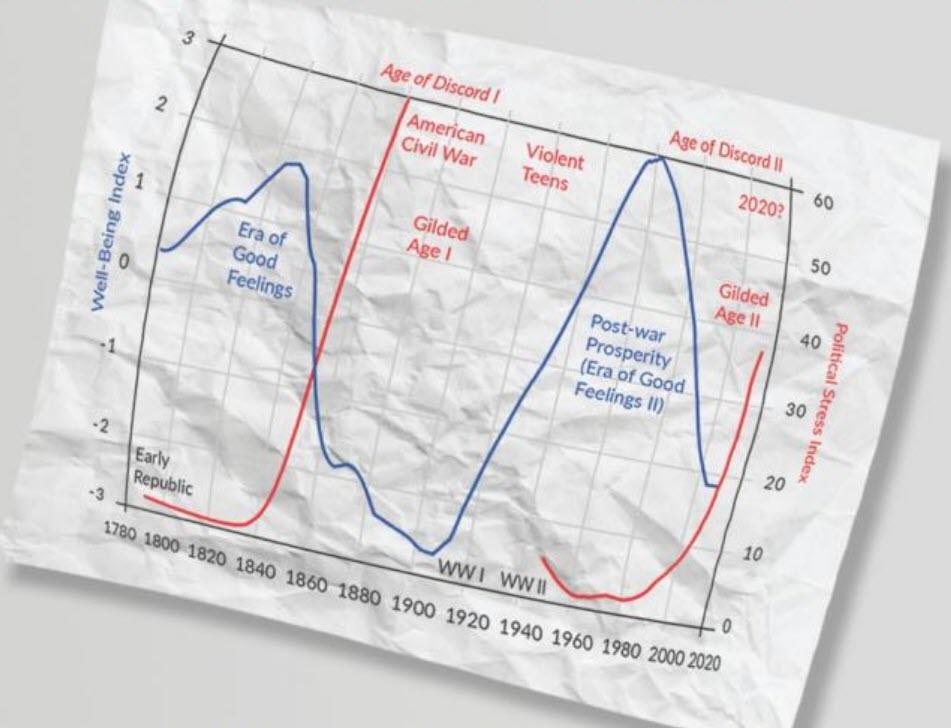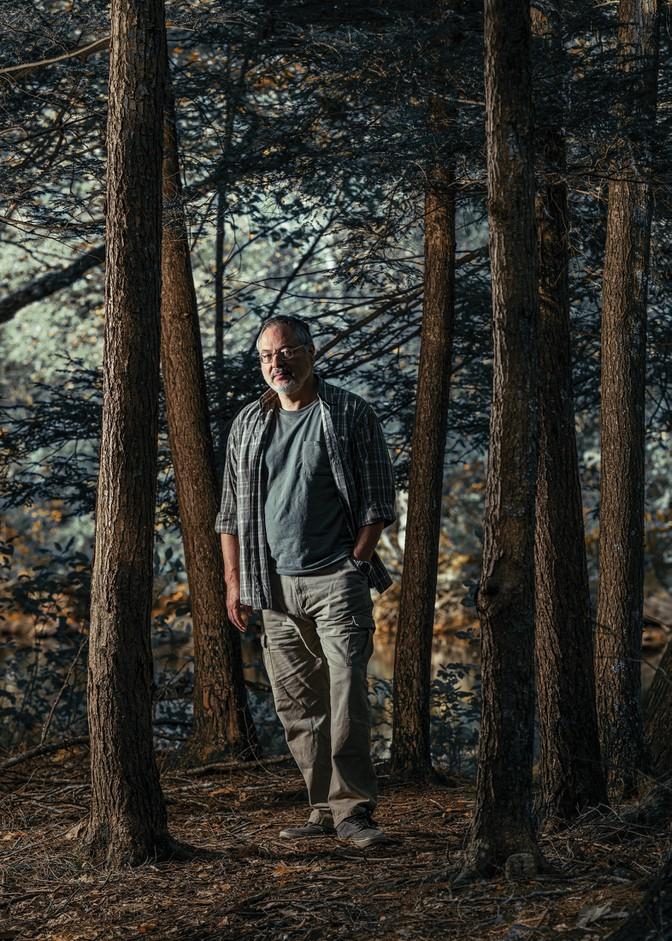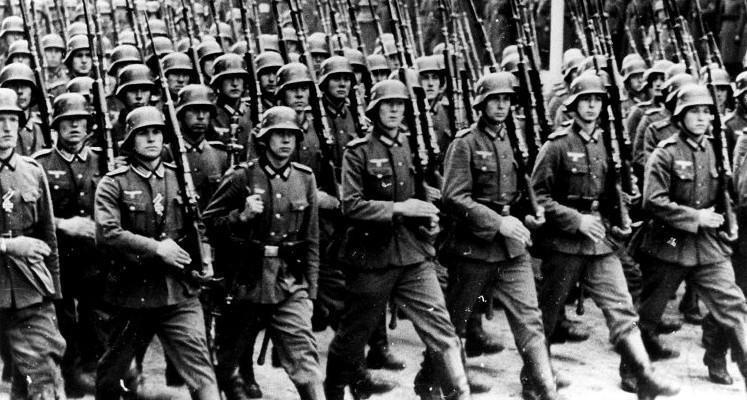
The Club of Rome in 1972 was prophetic with their early model predicting a social crash in the 2020s. Later the 4th turning authors tried to add a veneer of theory to the raw numbers in the late 1990s.
Now, peter Turchin is adding meat to the bones. But the results are the same: Decline and crash are at this stage unavoidable. This is less and less Casandra and more and more modeling and science.
The Next Decade Could Be Even Worse
Authored by Graeme Wood via The Atlantic,
A historian believes he has discovered iron laws that predict the rise and fall of societies. He has bad news...
Peter Turchin, one of the world’s experts on pine beetles and possibly also on human beings, met me reluctantly this summer on the campus of the University of Connecticut at Storrs, where he teaches. Like many people during the pandemic, he preferred to limit his human contact. He also doubted whether human contact would have much value anyway, when his mathematical models could already tell me everything I needed to know.
But he had to leave his office sometime. (“One way you know I am Russian is that I cannot think sitting down,” he told me. “I have to go for a walk.”) Neither of us had seen much of anyone since the pandemic had closed the country several months before. The campus was quiet. “A week ago, it was even more like a neutron bomb hit,” Turchin said. Animals were timidly reclaiming the campus, he said: squirrels, woodchucks, deer, even an occasional red-tailed hawk. During our walk, groundskeepers and a few kids on skateboards were the only other representatives of the human population in sight.
The year 2020 has been kind to Turchin, for many of the same reasons it has been hell for the rest of us. Cities on fire, elected leaders endorsing violence, homicides surging—to a normal American, these are apocalyptic signs. To Turchin, they indicate that his models, which incorporate thousands of years of data about human history, are working.
(“Not all of human history,” he corrected me once. “Just the last 10,000 years.”) He has been warning for a decade that a few key social and political trends portend an “age of discord,” civil unrest and carnage worse than most Americans have experienced.
In 2010, he predicted that the unrest would get serious around 2020, and that it wouldn’t let up until those social and political trends reversed. Havoc at the level of the late 1960s and early ’70s is the best-case scenario; all-out civil war is the worst.
The fundamental problems, he says, are a dark triad of social maladies: a bloated elite class, with too few elite jobs to go around; declining living standards among the general population; and a government that can’t cover its financial positions. His models, which track these factors in other societies across history, are too complicated to explain in a nontechnical publication. But they’ve succeeded in impressing writers for nontechnical publications, and have won him comparisons to other authors of “megahistories,” such as Jared Diamond and Yuval Noah Harari. The New York Times columnist Ross Douthat had once found Turchin’s historical modeling unpersuasive, but 2020 made him a believer: “At this point,” Douthat recently admitted on a podcast, “I feel like you have to pay a little more attention to him.”
Diamond and Harari aimed to describe the history of humanity. Turchin looks into a distant, science-fiction future for peers. In War and Peace and War (2006), his most accessible book, he likens himself to Hari Seldon, the “maverick mathematician” of Isaac Asimov’s Foundation series, who can foretell the rise and fall of empires. In those 10,000 years’ worth of data, Turchin believes he has found iron laws that dictate the fates of human societies.
The fate of our own society, he says, is not going to be pretty, at least in the near term. “It’s too late,” he told me as we passed Mirror Lake, which UConn’s website describes as a favorite place for students to “read, relax, or ride on the wooden swing.” The problems are deep and structural—not the type that the tedious process of democratic change can fix in time to forestall mayhem. Turchin likens America to a huge ship headed directly for an iceberg: “If you have a discussion among the crew about which way to turn, you will not turn in time, and you hit the iceberg directly.”
The past 10 years or so have been discussion. That sickening crunch you now hear—steel twisting, rivets popping—is the sound of the ship hitting the iceberg.
“We are almost guaranteed” five hellish years, Turchin predicts, and likely a decade or more. The problem, he says, is that there are too many people like me. “You are ruling class,” he said, with no more rancor than if he had informed me that I had brown hair, or a slightly newer iPhone than his. Of the three factors driving social violence, Turchin stresses most heavily “elite overproduction”—the tendency of a society’s ruling classes to grow faster than the number of positions for their members to fill. One way for a ruling class to grow is biologically—think of Saudi Arabia, where princes and princesses are born faster than royal roles can be created for them. In the United States, elites overproduce themselves through economic and educational upward mobility: More and more people get rich, and more and more get educated. Neither of these sounds bad on its own. Don’t we want everyone to be rich and educated? The problems begin when money and Harvard degrees become like royal titles in Saudi Arabia. If lots of people have them, but only some have real power, the ones who don’t have power eventually turn on the ones who do.
In the United States, Turchin told me, you can see more and more aspirants fighting for a single job at, say, a prestigious law firm, or in an influential government sinecure, or (here it got personal) at a national magazine. Perhaps seeing the holes in my T-shirt, Turchin noted that a person can be part of an ideological elite rather than an economic one. (He doesn’t view himself as a member of either. A professor reaches at most a few hundred students, he told me. “You reach hundreds of thousands.”) Elite jobs do not multiply as fast as elites do. There are still only 100 Senate seats, but more people than ever have enough money or degrees to think they should be running the country. “You have a situation now where there are many more elites fighting for the same position, and some portion of them will convert to counter-elites,” Turchin said.
Donald Trump, for example, may appear elite (rich father, Wharton degree, gilded commodes), but Trumpism is a counter-elite movement. His government is packed with credentialed nobodies who were shut out of previous administrations, sometimes for good reasons and sometimes because the Groton-Yale establishment simply didn’t have any vacancies. Trump’s former adviser and chief strategist Steve Bannon, Turchin said, is a “paradigmatic example” of a counter-elite. He grew up working-class, went to Harvard Business School, and got rich as an investment banker and by owning a small stake in the syndication rights to Seinfeld. None of that translated to political power until he allied himself with the common people. “He was a counter-elite who used Trump to break through, to put the white working males back in charge,” Turchin said.
Elite overproduction creates counter-elites, and counter-elites look for allies among the commoners. If commoners’ living standards slip—not relative to the elites, but relative to what they had before—they accept the overtures of the counter-elites and start oiling the axles of their tumbrels. Commoners’ lives grow worse, and the few who try to pull themselves onto the elite lifeboat are pushed back into the water by those already aboard. The final trigger of impending collapse, Turchin says, tends to be state insolvency. At some point rising insecurity becomes expensive. The elites have to pacify unhappy citizens with handouts and freebies—and when these run out, they have to police dissent and oppress people. Eventually the state exhausts all short-term solutions, and what was heretofore a coherent civilization disintegrates.
Turchin’s prognostications would be easier to dismiss as barstool theorizing if the disintegration were not happening now, roughly as the Seer of Storrs foretold 10 years ago. If the next 10 years are as seismic as he says they will be, his insights will have to be accounted for by historians and social scientists—assuming, of course, that there are still universities left to employ such people.
Peter Turchin, photographed in Connecticut’s Natchaug State Forest in October. The former ecologist seeks to apply mathematical rigor to the study of human history. (Malike Sidibe)
Turchin was born in 1957 in Obninsk, Russia, a city built by the Soviet state as a kind of nerd heaven, where scientists could collaborate and live together. His father, Valentin, was a physicist and political dissident, and his mother, Tatiana, had trained as a geologist. They moved to Moscow when he was 7 and in 1978 fled to New York as political refugees. There they quickly found a community that spoke the household language, which was science. Valentin taught at the City University of New York, and Peter studied biology at NYU and earned a zoology doctorate from Duke.
Turchin wrote a dissertation on the Mexican bean beetle, a cute, ladybuglike pest that feasts on legumes in areas between the United States and Guatemala. When Turchin began his research, in the early 1980s, ecology was evolving in a way that some fields already had. The old way to study bugs was to collect them and describe them: count their legs, measure their bellies, and pin them to pieces of particleboard for future reference. (Go to the Natural History Museum in London, and in the old storerooms you can still see the shelves of bell jars and cases of specimens.) In the ’70s, the Australian physicist Robert May had turned his attention to ecology and helped transform it into a mathematical science whose tools included supercomputers along with butterfly nets and bottle traps. Yet in the early days of his career, Turchin told me, “the majority of ecologists were still quite math-phobic.”
Turchin did, in fact, do fieldwork, but he contributed to ecology primarily by collecting and using data to model the dynamics of populations—for example, determining why a pine-beetle population might take over a forest, or why that same population might decline. (He also worked on moths, voles, and lemmings.)
In the late ’90s, disaster struck: Turchin realized that he knew everything he ever wanted to know about beetles. He compares himself to Thomasina Coverly, the girl genius in the Tom Stoppard play Arcadia, who obsessed about the life cycles of grouse and other creatures around her Derbyshire country house. Stoppard’s character had the disadvantage of living a century and a half before the development of chaos theory. “She gave up because it was just too complicated,” Turchin said. “I gave up because I solved the problem.”
Turchin published one final monograph, Complex Population Dynamics: A Theoretical / Empirical Synthesis (2003), then broke the news to his UConn colleagues that he would be saying a permanent sayonara to the field, although he would continue to draw a salary as a tenured professor in their department. (He no longer gets raises, but he told me he was already “at a comfortable level, and, you know, you don’t need so much money.”) “Usually a midlife crisis means you divorce your old wife and marry a graduate student,” Turchin said. “I divorced an old science and married a new one.”
Turchin’s prognostications would be easier to dismiss as barstool theorizing if they weren’t playing out now, roughly as he foretold 10 years ago.
One of his last papers appeared in the journal Oikos. “Does population ecology have general laws?” Turchin asked. Most ecologists said no: Populations have their own dynamics, and each situation is different. Pine beetles reproduce, run amok, and ravage a forest for pine-beetle reasons, but that does not mean mosquito or tick populations will rise and fall according to the same rhythms. Turchin suggested that “there are several very general law-like propositions” that could be applied to ecology. After its long adolescence of collecting and cataloging, ecology had enough data to describe these universal laws—and to stop pretending that every species had its own idiosyncrasies. “Ecologists know these laws and should call them laws,” he said. Turchin proposed, for example, that populations of organisms grow or decline exponentially, not linearly. This is why if you buy two guinea pigs, you will soon have not just a few more guinea pigs but a home—and then a neighborhood—full of the damn things (as long as you keep feeding them). This law is simple enough to be understood by a high-school math student, and it describes the fortunes of everything from ticks to starlings to camels. The laws Turchin applied to ecology—and his insistence on calling them laws—generated respectful controversy at the time. Now they are cited in textbooks.
Having left ecology, Turchin began similar research that attempted to formulate general laws for a different animal species: human beings. He’d long had a hobbyist’s interest in history. But he also had a predator’s instinct to survey the savanna of human knowledge and pounce on the weakest prey. “All sciences go through this transition to mathematization,” Turchin told me. “When I had my midlife crisis, I was looking for a subject where I could help with this transition to a mathematized science. There was only one left, and that was history.”
Historians read books, letters, and other texts. Occasionally, if they are archaeologically inclined, they dig up potsherds and coins. But to Turchin, relying solely on these methods was the equivalent of studying bugs by pinning them to particleboard and counting their antennae. If the historians weren’t going to usher in a mathematical revolution themselves, he would storm their departments and do it for them.
“There is a longstanding debate among scientists and philosophers as to whether history has general laws,” he and a co-author wrote in Secular Cycles (2009). “A basic premise of our study is that historical societies can be studied with the same methods physicists and biologists used to study natural systems.” Turchin founded a journal, Cliodynamics, dedicated to “the search for general principles explaining the functioning and dynamics of historical societies.” (The term is his coinage; Clio is the muse of history.) He had already announced the discipline’s arrival in an article in Nature, where he likened historians reluctant to build general principles to his colleagues in biology “who care most for the private life of warblers.” “Let history continue to focus on the particular,” he wrote. Cliodynamics would be a new science. While historians dusted bell jars in the basement of the university, Turchin and his followers would be upstairs, answering the big questions.
To seed the journal’s research, Turchin masterminded a digital archive of historical and archaeological data. The coding of its records requires finesse, he told me, because (for example) the method of determining the size of the elite-aspirant class of medieval France might differ from the measure of the same class in the present-day United States. (For medieval France, a proxy is the membership in its noble class, which became glutted with second and third sons who had no castles or manors to rule over. One American proxy, Turchin says, is the number of lawyers.) But once the data are entered, after vetting by Turchin and specialists in the historical period under review, they offer quick and powerful suggestions about historical phenomena.
Historians of religion have long pondered the relationship between the rise of complex civilization and the belief in gods—especially “moralizing gods,” the kind who scold you for sinning. Last year, Turchin and a dozen co-authors mined the database (“records from 414 societies that span the past 10,000 years from 30 regions around the world, using 51 measures of social complexity and 4 measures of supernatural enforcement of morality”) to answer the question conclusively. They found that complex societies are more likely to have moralizing gods, but the gods tend to start their scolding after the societies get complex, not before. As the database expands, it will attempt to remove more questions from the realm of humanistic speculation and sock them away in a drawer marked answered.
One of Turchin’s most unwelcome conclusions is that complex societies arise through war. The effect of war is to reward communities that organize themselves to fight and survive, and it tends to wipe out ones that are simple and small-scale. “No one wants to accept that we live in the societies we do”—rich, complex ones with universities and museums and philosophy and art—“because of an ugly thing like war,” he said. But the data are clear: Darwinian processes select for complex societies because they kill off simpler ones. The notion that democracy finds its strength in its essential goodness and moral improvement over its rival systems is likewise fanciful. Instead, democratic societies flourish because they have a memory of being nearly obliterated by an external enemy. They avoided extinction only through collective action, and the memory of that collective action makes democratic politics easier to conduct in the present, Turchin said. “There is a very close correlation between adopting democratic institutions and having to fight a war for survival.”
Also unwelcome: the conclusion that civil unrest might soon be upon us, and might reach the point of shattering the country. In 2012, Turchin published an analysis of political violence in the United States, again starting with a database. He classified 1,590 incidents—riots, lynchings, any political event that killed at least one person—from 1780 to 2010. Some periods were placid and others bloody, with peaks of brutality in 1870, 1920, and 1970, a 50-year cycle. Turchin excludes the ultimate violent incident, the Civil War, as a “sui generis event.” The exclusion may seem suspicious, but to a statistician, “trimming outliers” is standard practice. Historians and journalists, by contrast, tend to focus on outliers—because they are interesting—and sometimes miss grander trends.
Certain aspects of this cyclical view require relearning portions of American history, with special attention paid to the numbers of elites. The industrialization of the North, starting in the mid-19th century, Turchin says, made huge numbers of people rich. The elite herd was culled during the Civil War, which killed off or impoverished the southern slaveholding class, and during Reconstruction, when America experienced a wave of assassinations of Republican politicians. (The most famous of these was the assassination of James A. Garfield, the 20th president of the United States, by a lawyer who had demanded but not received a political appointment.) It wasn’t until the Progressive reforms of the 1920s, and later the New Deal, that elite overproduction actually slowed, at least for a time.
This oscillation between violence and peace, with elite overproduction as the first horseman of the recurring American apocalypse, inspired Turchin’s 2020 prediction. In 2010, when Nature surveyed scientists about their predictions for the coming decade, most took the survey as an invitation to self-promote and rhapsodize, dreamily, about coming advances in their fields. Turchin retorted with his prophecy of doom and said that nothing short of fundamental change would stop another violent turn.
Turchin’s prescriptions are, as a whole, vague and unclassifiable. Some sound like ideas that might have come from Senator Elizabeth Warren—tax the elites until there are fewer of them—while others, such as a call to reduce immigration to keep wages high for American workers, resemble Trumpian protectionism. Other policies are simply heretical. He opposes credential-oriented higher education, for example, which he says is a way of mass-producing elites without also mass-producing elite jobs for them to occupy. Architects of such policies, he told me, are “creating surplus elites, and some become counter-elites.” A smarter approach would be to keep the elite numbers small, and the real wages of the general population on a constant rise.
How to do that? Turchin says he doesn’t really know, and it isn’t his job to know. “I don’t really think in terms of specific policy,” he told me. “We need to stop the runaway process of elite overproduction, but I don’t know what will work to do that, and nobody else does. Do you increase taxation? Raise the minimum wage? Universal basic income?” He conceded that each of these possibilities would have unpredictable effects. He recalled a story he’d heard back when he was still an ecologist: The Forest Service had once implemented a plan to reduce the population of bark beetles with pesticide—only to find that the pesticide killed off the beetles’ predators even more effectively than it killed the beetles. The intervention resulted in more beetles than before. The lesson, he said, was to practice “adaptive management,” changing and modulating your approach as you go.
Eventually, Turchin hopes, our understanding of historical dynamics will mature to the point that no government will make policy without reflecting on whether it is hurtling toward a mathematically preordained disaster. He says he could imagine an Asimovian agency that keeps tabs on leading indicators and advises accordingly. It would be like the Federal Reserve, but instead of monitoring inflation and controlling monetary supply, it would be tasked with averting total civilizational collapse.
Historians have not, as a whole, accepted Turchin’s terms of surrender graciously. Since at least the 19th century, the discipline has embraced the idea that history is irreducibly complex, and by now most historians believe that the diversity of human activity will foil any attempt to come up with general laws, especially predictive ones. (As Jo Guldi, a historian at Southern Methodist University, put it to me, “Some historians regard Turchin the way astronomers regard Nostradamus.”) Instead, each historical event must be lovingly described, and its idiosyncrasies understood to be limited in relevance to other events. The idea that one thing causes another, and that the causal pattern can tell you about sequences of events in another place or century, is foreign territory.
One might even say that what defines history as a humanistic enterprise is the belief that it is not governed by scientific laws—that the working parts of human societies are not like billiard balls, which, if arranged at certain angles and struck with a certain amount of force, will invariably crack just so and roll toward a corner pocket of war, or a side pocket of peace. Turchin counters that he has heard claims of irreducible complexity before, and that steady application of the scientific method has succeeded in managing that complexity. Consider, he says, the concept of temperature—something so obviously quantifiable now that we laugh at the idea that it’s too vague to measure. “Back before people knew what temperature was, the best thing you could do is to say you’re hot or cold,” Turchin told me. The concept depended on many factors: wind, humidity, ordinary human differences in perception. Now we have thermometers. Turchin wants to invent a thermometer for human societies that will measure when they are likely to boil over into war.
Eventually, Turchin hopes, no government will make policy without reflecting on whether it is hurtling toward a mathematically preordained disaster.
One social scientist who can speak to Turchin in his own mathematical argot is Dingxin Zhao, a sociology professor at the University of Chicago who is—incredibly—also a former mathematical ecologist. (He earned a doctorate modeling carrot-weevil population dynamics before earning a second doctorate in Chinese political sociology.) “I came from a natural-science background,” Zhao told me, “and in a way I am sympathetic to Turchin. If you come to social science from natural sciences, you have a powerful way of looking at the world. But you may also make big mistakes.”
Zhao said that human beings are just much more complicated than bugs. “Biological species don’t strategize in a very flexible way,” he told me. After millennia of evolutionary R&D, a woodpecker will come up with ingenious ways to stick its beak into a tree in search of food. It might even have social characteristics—an alpha woodpecker might strong-wing beta woodpeckers into giving it first dibs on the tastiest termites. But humans are much wilier social creatures, Zhao said. A woodpecker will eat a termite, but it “will not explain that he is doing so because it is his divine right.” Humans pull ideological power moves like this all the time, Zhao said, and to understand “the decisions of a Donald Trump, or a Xi Jinping,” a natural scientist has to incorporate the myriad complexities of human strategy, emotion, and belief. “I made that change,” Zhao told me, “and Peter Turchin has not.”
Turchin is nonetheless filling a historiographical niche left empty by academic historians with allergies not just to science but to a wide-angle view of the past. He places himself in a Russian tradition prone to thinking sweeping, Tolstoyan thoughts about the path of history. By comparison, American historians mostly look like micro-historians. Few would dare to write a history of the United States, let alone one of human civilization. Turchin’s approach is also Russian, or post-Soviet, in its rejection of the Marxist theory of historical progress that had been the official ideology of the Soviet state. When the U.S.S.R. collapsed, so too did the requirement that historical writing acknowledge international communism as the condition toward which the arc of history was bending. Turchin dropped ideology altogether, he says: Rather than bending toward progress, the arc in his view bends all the way back on itself, in a never-ending loop of boom and bust. This puts him at odds with American historians, many of whom harbor an unspoken faith that liberal democracy is the end state of all history.
Writing history in this sweeping, cyclical way is easier if you are trained outside the field. “If you look at who is doing these megahistories, more often than not, it’s not actual historians,” Walter Scheidel, an actual historian at Stanford, told me. (Scheidel, whose books span millennia, takes Turchin’s work seriously and has even co-written a paper with him.) Instead they come from scientific fields where these taboos do not dominate. The genre’s most famous book, Guns, Germs, and Steel (1997), beheld 13,000 years of human history in a single volume. Its author, Jared Diamond, spent the first half of his career as one of the world’s foremost experts on the physiology of the gallbladder. Steven Pinker, a cognitive psychologist who studies how children acquire parts of speech, has written a megahistory about the decline of violence across thousands of years, and about human flourishing since the Enlightenment. Most historians I asked about these men—and for some reason megahistory is nearly always a male pursuit—used terms like laughingstock and patently tendentious to describe them.
Pinker retorts that historians are resentful of the attention “disciplinary carpetbaggers” like himself have received for applying scientific methods to the humanities and coming up with conclusions that had eluded the old methods. He is skeptical of Turchin’s claims about historical cycles, but he believes in data-driven historical inquiry. “Given the noisiness of human behavior and the prevalence of cognitive biases, it’s easy to delude oneself about a historical period or trend by picking whichever event suits one’s narrative,” he says. The only answer is to use large data sets. Pinker thanks traditional historians for their work collating these data sets; he told me in an email that they “deserve extraordinary admiration for their original research (‘brushing the mouse shit off moldy court records in the basement of town halls,’ as one historian put it to me).” He calls not for surrender but for a truce. “There’s no reason that traditional history and data science can’t merge into a cooperative enterprise,” Pinker wrote. “Knowing stuff is hard; we need to use every available tool.”
Guldi, the Southern Methodist University professor, is one scholar who has embraced tools previously scorned by historians. She is a pioneer of data-driven history that considers timescales beyond a human lifetime. Her primary technique is the mining of texts—for example, sifting through the millions and millions of words captured in parliamentary debate in order to understand the history of land use in the final century of the British empire. Guldi may seem a potential recruit to cliodynamics, but her approach to data sets is grounded in the traditional methods of the humanities. She counts the frequency of words, rather than trying to find ways to compare big, fuzzy categories among civilizations. Turchin’s conclusions are only as good as his databases, she told me, and any database that tries to code something as complex as who constitutes a society’s elites—then tries to make like-to-like comparisons across millennia and oceans—will meet with skepticism from traditional historians, who deny that the subject to which they have devoted their lives can be expressed in Excel format. Turchin’s data are also limited to big-picture characteristics observed over 10,000 years, or about 200 lifetimes. By scientific standards, a sample size of 200 is small, even if it is all humanity has.
Yet 200 lifetimes is at least more ambitious than the average historical purview of only one. And the reward for that ambition—in addition to the bragging rights for having potentially explained everything that has ever happened to human beings—includes something every writer wants: an audience. Thinking small rarely gets you quoted in The New York Times. Turchin has not yet attracted the mass audiences of a Diamond, Pinker, or Harari. But he has lured connoisseurs of political catastrophe, journalists and pundits looking for big answers to pressing questions, and true believers in the power of science to conquer uncertainty and improve the world. He has certainly outsold most beetle experts.
If he is right, it is hard to see how history will avoid assimilating his insights—if it can avoid being abolished by them. Privately, some historians have told me they consider the tools he uses powerful, if a little crude. Cliodynamics is now on a long list of methods that arrived on the scene promising to revolutionize history. Many were fads, but some survived that stage to take their rightful place in an expanding historiographical tool kit. Turchin’s methods have already shown their power. Cliodynamics offers scientific hypotheses, and human history will give us more and more opportunities to check its predictions—revealing whether Peter Turchin is a Hari Seldon or a mere Nostradamus. For my own sake, there are few thinkers whom I am more eager to see proved wrong.







